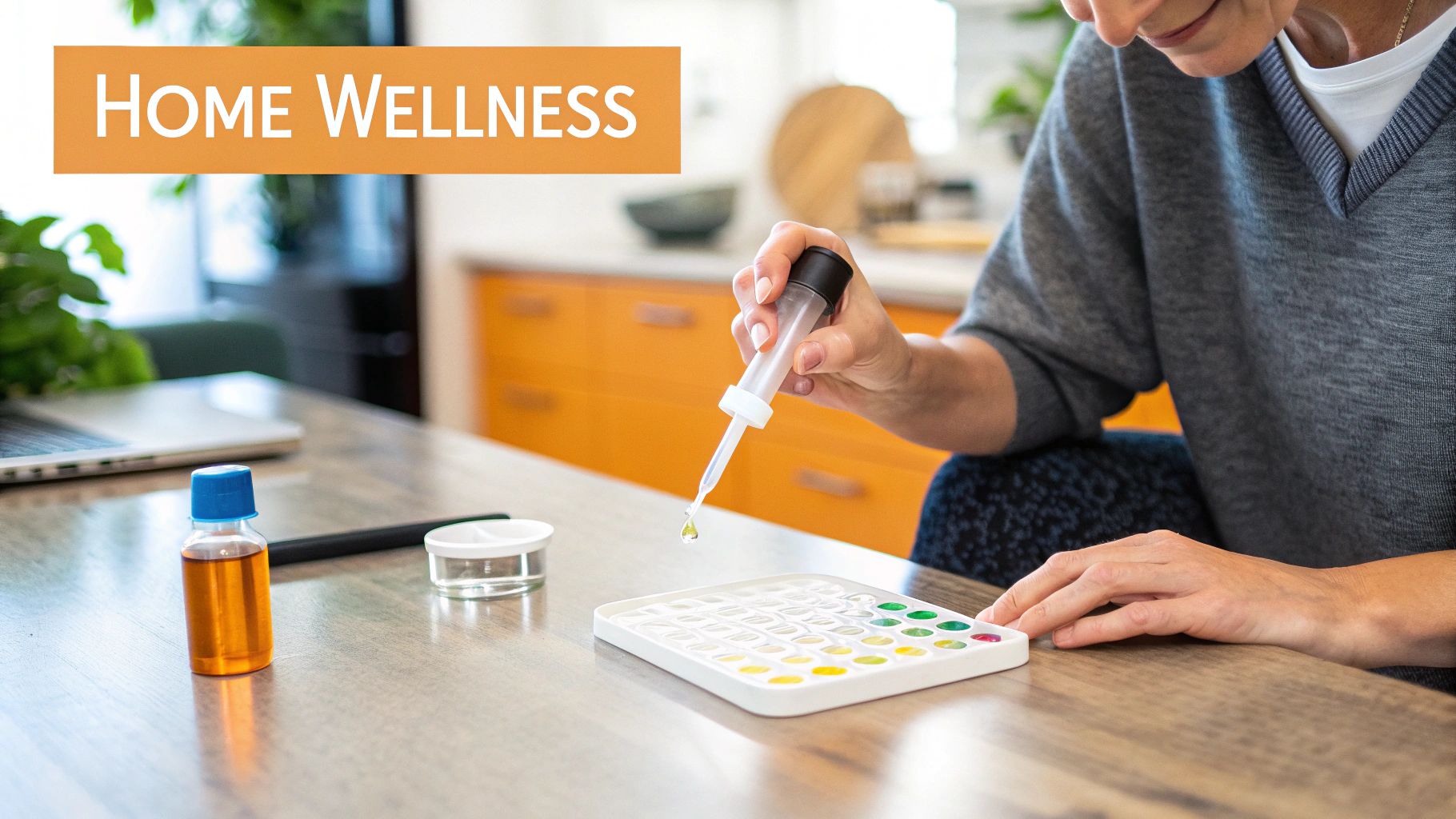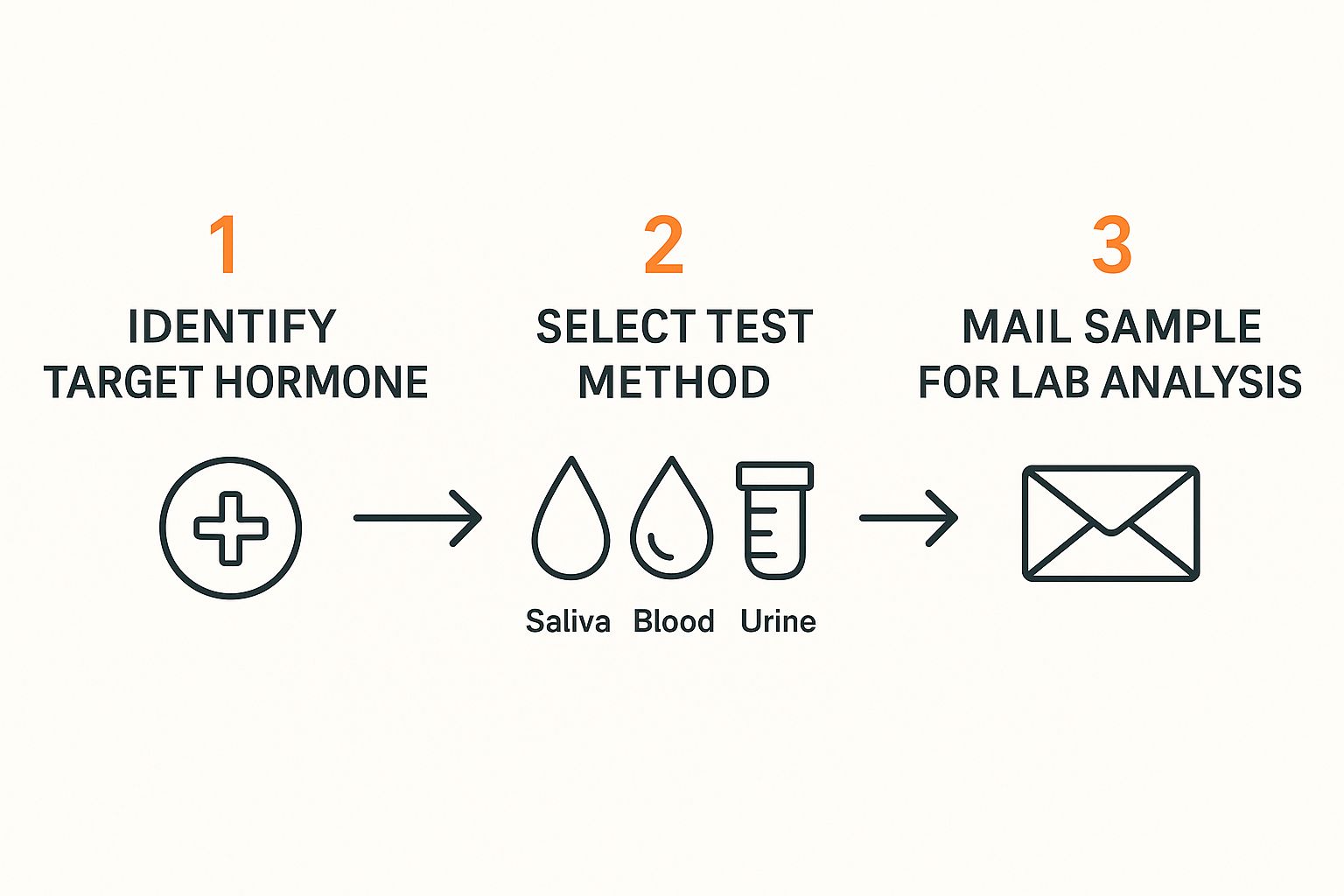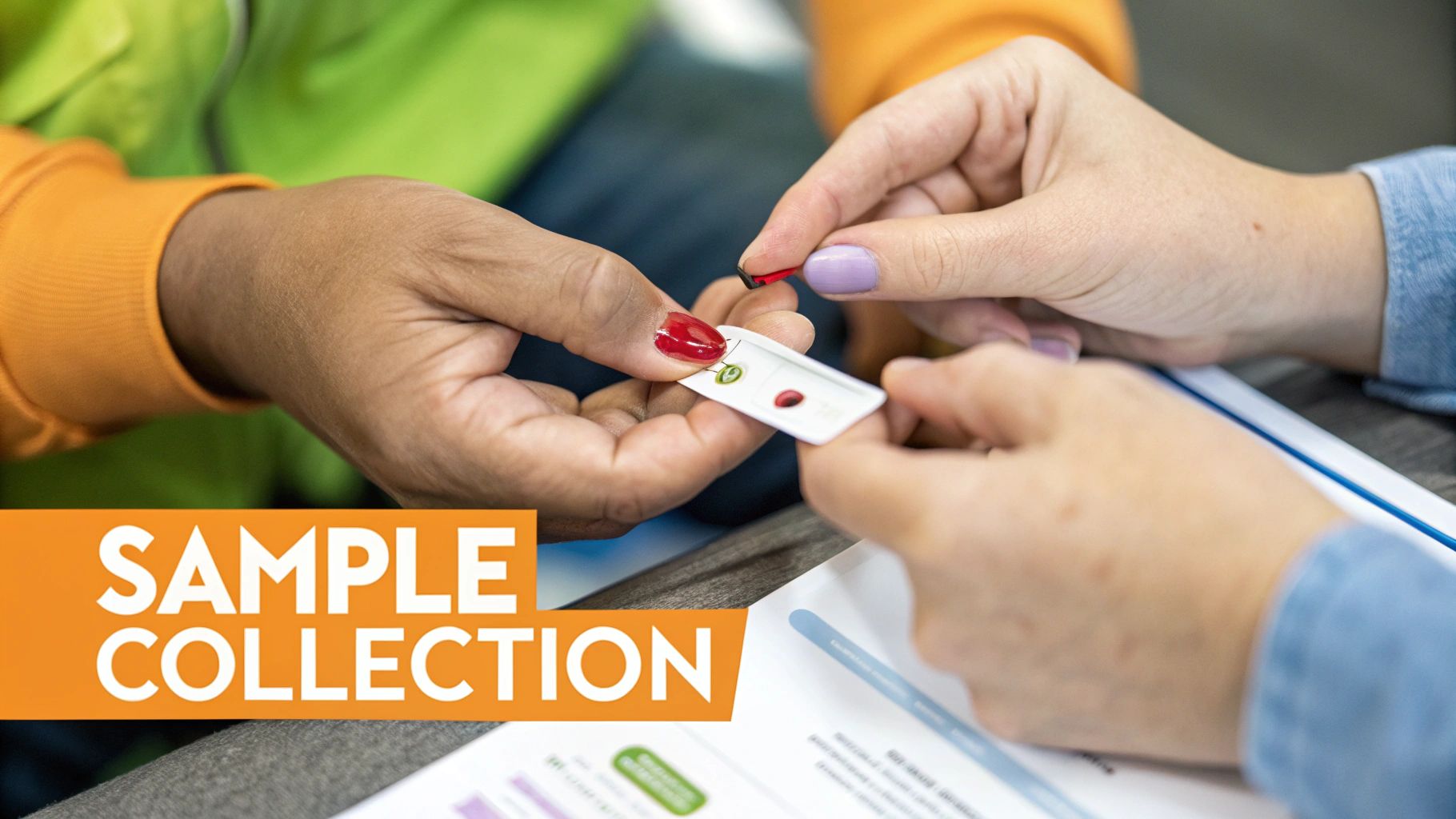How to Check Hormone Levels at Home The Definitive Guide

You can now check your hormone levels right from your own home using a simple kit that tests your saliva, urine, or a small blood spot sample. The whole process is designed to be straightforward: you choose a test that aligns with your symptoms, collect the sample by following the clear instructions, and mail it off to a lab. Once the analysis is done, you’ll get a detailed report, usually through a secure online portal.
Your Guide to At-Home Hormone Testing
Taking control of your health often starts with understanding what’s really going on inside your body. If you've been wrestling with unexplained fatigue, frustrating mood swings, or strange changes in your metabolism, your hormones could absolutely be the culprit. The good news is you no longer need to schedule a doctor's visit just to get some initial insights. At-home hormone testing gives you a private and incredibly convenient way to gather valuable data about your body's key chemical messengers.
The process is refreshingly simple. It all begins with identifying your symptoms so you can pick the right test, moves on to collecting a quick sample, and finishes with you receiving a detailed report that you can then discuss with a healthcare professional.
The Rise of At-Home Health Monitoring
The move toward at-home health solutions has been massive. The global market for at-home testing, which includes hormone diagnostics, hit about USD 7.43 billion in 2024. It’s not stopping there, either—it's projected to climb to nearly USD 11.88 billion by 2035. This surge is driven by a real consumer shift toward private, accessible health monitoring. This growth also reflects huge improvements in technology that have made tests for things like testosterone, thyroid function, and fertility much more reliable and user-friendly. You can find out more about the trends in the at-home testing market and its future growth.
Think of at-home tests as a powerful first step. They are screening tools, not a final diagnosis. Their purpose is to empower you with information that can guide your next conversation with a doctor.
Choosing the right test is your first, most critical move. If you have a specific concern, you can explore a dedicated home hormone test kit designed to match your symptoms.
Matching Symptoms to Hormones
To help you figure out where to start, it's incredibly helpful to connect common symptoms with the hormones that regulate them. This initial gut check can point you toward the most relevant test for what you're experiencing.
The table below gives you a quick overview, matching common issues to the hormones most likely involved.
Common At-Home Hormone Tests and Related Symptoms
| Hormone Panel | Key Hormones Measured | Common Associated Symptoms |
|---|---|---|
| Men's Health | Testosterone, Estradiol | Low energy, decreased libido, mood changes, difficulty building muscle |
| Women's Health | Estradiol, Progesterone, LH | Irregular periods, PMS, fertility challenges, menopausal symptoms |
| Thyroid Function | TSH, Free T3, Free T4 | Fatigue, weight gain or loss, hair thinning, sensitivity to cold |
| Stress & Sleep | Cortisol, DHEA | Anxiety, sleep disturbances, brain fog, chronic stress |
This isn't a diagnostic tool, of course, but it's a great starting point for identifying which area of your hormonal health might need a closer look. Once you have your results, you'll be in a much better position to seek targeted medical advice.
How to Choose the Right At-Home Hormone Test

With the explosion of at-home testing kits, picking the right one can feel overwhelming. The secret is to stop looking for the "best" test and start looking for the test that best matches your specific symptoms and health goals. Once you know what question you’re trying to answer, you can confidently find a kit that will give you the insights you need.
It all boils down to one simple question: are you trying to understand a constellation of vague symptoms, or do you have a single, specific concern? Your answer will point you toward either a comprehensive panel or a more focused, single-marker test.
Comprehensive Panels Versus Single-Marker Tests
Think of a comprehensive panel as using a wide-angle lens. If you’re dealing with a mix of frustrating symptoms like constant fatigue, mood swings, and weight changes that you can't explain, a panel that measures multiple hormones—like thyroid, cortisol, and key sex hormones—gives you the bigger picture. It’s designed to spot interconnected issues that you might otherwise miss.
A single-marker test, on the other hand, is like using a magnifying glass. It’s the perfect tool when you have a very targeted question. For instance, if you're trying to conceive, a test that only measures Luteinizing Hormone (LH) to pinpoint ovulation is exactly what you need. It’s focused, usually more affordable, and gives a clear answer to a specific question.
To figure out which is right for you, consider these common scenarios:
- Struggling with persistent fatigue and brain fog? A comprehensive panel looking at thyroid hormones (TSH, T4) and cortisol is a logical place to start.
- Need to track your fertile window? A simple, urine-based LH test is the most direct and efficient tool for identifying ovulation.
- Worried about low libido or energy? A targeted testosterone test can provide a specific data point to bring to a healthcare provider.
Vetting the Company Behind the Kit
Not all at-home tests are created equal. The reliability of your results is completely dependent on the standards of the company you choose. Before you click "buy," it's worth doing a little detective work on the provider.
First, and most importantly, make sure their labs are CLIA-certified. The Clinical Laboratory Improvement Amendments (CLIA) are federal standards that regulate lab testing to ensure accuracy and reliability. A company using a CLIA-certified lab is a non-negotiable mark of quality.
Next, look into their process for physician oversight. A reputable company will have a licensed physician review and approve your results before they’re sent to you. This step isn't just a rubber stamp; it adds a crucial layer of medical validation to the entire process.
The key thing to remember is that you're not just buying a piece of plastic; you're paying for the lab's accuracy and a medical professional’s review. Transparent pricing, without hidden fees for lab work or that physician review, is the hallmark of a company you can trust.
The growth in this space has been massive. In the United States, the at-home testing market was valued at USD 2.30 billion in 2024 and is expected to hit USD 3.59 billion by 2032. This boom is driven by better technology and a growing desire for convenient, private health monitoring. You can learn more about the evolving at-home testing market trends and what’s behind this growth.
Matching the Collection Method to Your Needs
The sample you'll need to collect—saliva, blood, or urine—isn't random. It’s determined by the specific hormone being measured, as each method has its own pros and cons.
-
Saliva Tests are non-invasive and fantastic for measuring hormones like cortisol. Since cortisol levels rise and fall dramatically throughout the day, a saliva test makes it easy to collect multiple samples at specific times to map out your daily rhythm.
-
Blood Spot Tests just require a simple finger prick to collect a few drops of blood on a special card. This method is common for hormones that are more stable in the bloodstream, like thyroid-stimulating hormone (TSH) or testosterone.
-
Urine Tests are most often used for tracking fertility hormones like LH. They are designed for frequent, daily testing to catch the rapid surge that signals ovulation is about to occur.
Finally, take a few minutes to read through customer reviews. They offer real-world feedback on things that matter, like how clear the instructions are, how easy (or difficult) the sample collection was, and how long it took to get results. This kind of insight can tell you a lot about the company's reliability and overall user experience.
Collecting Your Sample for Accurate Results
Okay, you've picked your kit. Now comes the part that makes or breaks the whole process: collecting your sample. Getting this right is completely in your hands, and it’s the most critical step for getting a result you can actually trust.
A sloppy collection can easily skew your numbers or even get the sample rejected by the lab. Trust me, there’s nothing more frustrating than going through the whole process just to find out you have to do it all over again. Following the instructions isn’t a suggestion—it’s the only way to get this right.
This chart breaks down the simple journey your test takes, from the moment you choose it to the final analysis.

No matter which test you’re taking, you can see that careful sample collection is the bridge between having a concern and getting real, lab-analyzed answers.
Mastering the Saliva Test
Saliva tests are super convenient, but they're also incredibly easy to contaminate. The golden rule here is simple: nothing in your mouth for at least 30-60 minutes before you spit. That means no food, no coffee, no smoking, no gum, and no brushing your teeth. Anything other than plain water can throw off the sample.
Timing is just as important, especially for a hormone like cortisol. Cortisol has a natural daily rhythm—it’s highest when you wake up and lowest before bed. A "cortisol curve" test is designed to map this rhythm, so it will require you to collect spit at very specific times throughout the day, like right after waking, before lunch, and again before bed.
Sticking to that schedule isn’t optional. If you miss a collection time or do them out of order, the picture of your adrenal function will be completely distorted.
Best Practices for Blood Spot Collection
The finger-prick test can feel a little daunting, but there are a few tricks to make it painless and effective. The main goal is to get a good, steady blood flow so you can fill the circles on the card without squeezing your finger. Milking your finger is a big no-no; it damages the red blood cells and can ruin the sample.
To get the blood flowing, try these simple hacks:
- Get Warm: Run your hands under warm water or swing your arms around for a minute. It makes a huge difference.
- Hydrate: Drink a big glass of water about 20-30 minutes before you plan to do the test.
- Use Gravity: Let your arm hang down below your heart for a minute or so right before you prick your finger.
Once you’re ready, always prick the side of your fingertip, not the pad. It has fewer nerve endings, so it hurts less. Let a big, round drop of blood form, and then gently touch it to the center of a circle on the card. Let it soak all the way through.
Pro Tip: Whatever you do, don't touch the card with your finger. You want the blood drop to fall onto the paper. This prevents smearing and gives the lab a clean, concentrated spot to analyze.
The Critical Role of Timing Your Test
Beyond the immediate collection technique, the timing of your test within your monthly or daily cycle is everything for certain hormones. Hormones fluctuate naturally, and testing on the wrong day can give you a result that’s technically accurate but completely misleading.
Here are a few real-world examples:
- Testosterone: Levels are highest in the morning. That’s why nearly every at-home testosterone kit will tell you to collect your sample within 30 minutes of waking up.
- Progesterone: To see if you’ve actually ovulated, you need to test progesterone when it's at its peak. This happens during the mid-luteal phase, which for most women is around days 19-21 of a 28-day cycle. Test too early, and your levels will look low even if everything is perfectly normal.
- Fertility Hormones (LH): If you're using urine strips to track your ovulation surge, testing first thing in the morning with concentrated urine is usually best. It's also worth knowing that women with conditions like PCOS can have high LH all the time, which can sometimes lead to confusing false positives.
Ignoring these cycles is probably the number one reason people get results that don’t make any sense. Always read the kit’s instructions on timing and line them up with your own cycle tracking.
Making Sense of Your Hormone Test Results

The email you've been waiting for finally lands in your inbox. You click the link, log into the secure portal, and there it is—a report filled with numbers, acronyms, and graphs. It’s a moment that’s both exciting and, let's be honest, a little overwhelming. You've figured out how to check your hormone levels at home, but the next challenge is translating this raw data into something meaningful.
Your report isn’t just a list of figures. It’s a snapshot of your body’s intricate communication network at a single moment in time. Making sense of it is the next critical step, not so you can diagnose yourself, but so you can have a much smarter, more informed conversation with your healthcare provider.
Decoding the Reference Range
Every result on your report will be listed next to a "reference range." This is simply the spectrum of values that the lab considers typical for a healthy person. But here’s the thing: “normal” is a surprisingly flexible term.
These ranges aren’t universal. They can shift significantly based on a few key factors:
- Your Age: Hormone levels are not static. A normal testosterone level for a 25-year-old is worlds away from what’s typical for a 65-year-old.
- Your Sex: Men and women have fundamentally different hormonal baselines for markers like estradiol and testosterone.
- The Lab Itself: Different laboratories use slightly different equipment and analytical methods, which can lead to minor variations in their established reference ranges.
For this reason, you should only ever compare your numbers to the specific range provided by the lab that processed your sample. Seeing a number flagged as “high” or “low” is just an alert, a signal that your result falls outside of that typical spectrum. It’s the starting point for a closer look, not a conclusion.
The demand for this kind of personal health data is exploding. The global home testing kits market, which includes these hormone tests, hit USD 13.4 billion in 2024. It's projected to more than double to USD 27.6 billion by 2035, driven by the convenience and privacy these kits offer for tracking fertility, thyroid, and sex hormones. This growth is empowering people to get proactive about their health with simple saliva, urine, or blood samples. You can explore more data on the explosive growth of the home testing market to see just how big this shift is.
Interpreting Key Hormone Markers
While a doctor's expertise is irreplaceable, having a basic grasp of what key hormones do will help you prepare for that conversation. Let’s walk through a couple of common scenarios to see how these markers can be interpreted.
Imagine your thyroid panel comes back showing a high TSH (Thyroid-Stimulating Hormone) but a low Free T4. TSH is the signal from your pituitary gland telling your thyroid to get to work. A high TSH is like your brain "shouting" at your thyroid, which often suggests your thyroid isn't responding well and producing enough hormone (a classic pattern for hypothyroidism).
Or, let's look at fertility hormones. Doctors often analyze the estradiol to progesterone ratio in the second half of the menstrual cycle. If your progesterone is low relative to your estradiol, it could point to an anovulatory cycle (meaning an egg wasn't released) or what some call "estrogen dominance."
Remember, these are not diagnoses. They are patterns and clues. Hormones work together in a complex symphony, and one out-of-range marker is just a single note. A healthcare professional is needed to interpret the entire musical piece.
Understanding the function of each hormone marker provides context for your results. The table below outlines some of the most common hormones you might see on a report and what their levels could indicate.
Understanding Key Hormone Markers in Your Report
A guide to interpreting common hormone levels, their functions, and what out-of-range results might suggest for discussion with a doctor.
| Hormone | Primary Function | What High Levels Might Suggest | What Low Levels Might Suggest |
|---|---|---|---|
| TSH | Stimulates the thyroid gland | Underactive thyroid (hypothyroidism) | Overactive thyroid (hyperthyroidism) |
| Free T4 | A primary thyroid hormone, regulates metabolism | Overactive thyroid (hyperthyroidism) | Underactive thyroid (hypothyroidism) |
| Estradiol (E2) | Main female sex hormone, regulates menstrual cycle | PCOS, estrogen dominance, certain tumors | Menopause, ovarian failure, low body fat |
| Progesterone | Prepares uterus for pregnancy, balances estrogen | Pregnancy, certain ovarian cysts | Anovulatory cycles, PCOS, menopause |
| Testosterone | Primary male sex hormone, affects muscle, libido, mood | PCOS (in women), adrenal or testicular tumors | Hypogonadism, aging, chronic illness |
| Cortisol | The "stress hormone," regulates metabolism and inflammation | Cushing's syndrome, chronic stress | Addison's disease, adrenal fatigue |
This table is a starting point. Your doctor will interpret these values within the full context of your health, symptoms, and other lab results.
From Data Points to a Diagnosis
It's so tempting to jump onto Google and start self-diagnosing, but your at-home test results are just one piece of a much larger puzzle. They provide excellent quantitative data, but they’re missing the qualitative context that only a medical professional can bring.
Your doctor will integrate these numbers with other critical information:
- Your Personal Symptoms: How you actually feel day-to-day is just as important as what the numbers say. Fatigue, brain fog, and weight gain are all vital clues.
- Your Medical History: Your past conditions, surgeries, and family history all add crucial layers to the story.
- Your Lifestyle: Factors like chronic stress, your diet, sleep quality, and exercise habits have a massive impact on hormone levels.
Think of your test results as your ticket to a much more productive discussion. You can use them to ask specific, targeted questions. Instead of just saying, "I feel tired all the time," you can now say, "My report shows my morning cortisol is at the very bottom of the reference range, and I've been feeling completely drained. Could these two things be related?" This kind of specific, informed inquiry is what leads to truly effective and personalized care.
So, Your Hormone Test Results Are In. What's Next?

The results are finally here. After weeks of wondering, you’re holding a report that offers a real look into your body’s hormonal inner workings. This is where the real power of at-home testing begins—not as a final diagnosis, but as the starting point for taking control.
It’s crucial to remember what this test is: a powerful screening tool. It gives you valuable data that can shine a light on potential imbalances, but it is not a substitute for a professional medical diagnosis. The most important thing you can do now is share these findings with a qualified healthcare provider who can see the big picture.
Finding the Right Professional to Guide You
With your results in hand, the next step is finding a medical expert who can connect the numbers on the page to the symptoms you’ve been feeling. Not every doctor specializes in hormonal health, so finding the right person is key.
You have a few great options:
- Telehealth Providers: Online clinics have made it incredibly easy to connect with specialists without leaving home. They're often pros at interpreting at-home test results and can offer a straightforward path to treatment.
- Endocrinologists: These are the true specialists in hormones and the endocrine system. If your results point to something complex, like a major thyroid or adrenal issue, an endocrinologist is your best bet.
- Functional Medicine Practitioners: These professionals look at the whole system—how your lifestyle, diet, and environment are impacting your hormones. They excel at finding root causes and building personalized wellness plans.
No matter which path you choose, the goal is the same: have a productive, data-driven conversation about your health.
How to Prepare for Your Medical Consultation
Walking into an appointment prepared can make all the difference. Your at-home test results are a powerful starting point, but they become even more effective when you pair them with your own organized observations. After all, you're the expert on your own body.
Before your appointment, spend a little time getting your information together. Having everything ready to go will help you make the most of your time with the doctor and ensure all your questions get answered.
Key takeaway: Your job is to bring the data (your test results) and the story (your symptoms). The doctor’s job is to put them together to see the whole picture. A successful consultation needs both.
To set yourself up for success, gather these items:
- Your Full Test Report: Don’t just bring a summary. Have the complete digital report accessible or print it out, including the lab's reference ranges.
- A Symptom Log: For at least a week before your appointment, jot down how you feel. Note your energy levels, mood, sleep quality, and any other physical symptoms. The more specific, the better.
- A List of Questions: It’s so easy to forget what you wanted to ask in the moment. Write down your questions ahead of time to help guide the conversation.
Questions to Ask Your Doctor
This consultation is your chance to get clarity and build a plan. Having a list of smart questions ready ensures you leave understanding your results and your next steps. These questions can help you steer the conversation in the right direction.
Consider asking some of the following:
- Looking at these specific results, do you see any patterns that concern you?
- What other tests, if any, would you recommend to confirm these findings?
- How might my current lifestyle—like my diet, stress, or sleep—be influencing these hormone levels?
- Are there any non-prescription supplements or lifestyle changes you think could help?
- If my results point to an imbalance like low testosterone, you might be interested in science-based strategies that can support a professional treatment plan. For more details, check out our guide on the secrets to boosting testosterone levels.
- What are the next steps for creating a treatment plan if we decide one is necessary?
By taking these proactive steps, you turn your at-home test from a page of numbers into a powerful tool for improving your health and well-being.
Common Questions About At-Home Hormone Testing
Even with a plan, it's totally normal to have a few questions lingering in the back of your mind before you dive into at-home hormone testing. Taking a proactive step for your health is a big deal, and you want to feel confident you're doing it right.
Let's walk through some of the most common questions I hear from people, clearing up everything from accuracy to timing.
Are At-Home Hormone Tests Accurate
This is easily the biggest question on everyone’s mind, and the answer is yes—but with a major condition. The accuracy of your test hinges on two critical factors: the quality of the lab doing the analysis and how well you follow the collection instructions.
Reputable at-home testing companies partner exclusively with CLIA-certified laboratories. This is a federal standard that holds these labs to the same strict requirements for accuracy and reliability as the labs your doctor uses. When a CLIA-certified lab processes your sample, you can trust the results are just as precise as those from a traditional blood draw at a clinic.
However, even the best lab can't produce an accurate result from a compromised sample. Your part is just as important. Following the collection instructions to the letter is essential—whether that means testing at a specific time of day or fasting beforehand. Getting this step right is completely in your control and makes all the difference.
How Often Should I Test My Hormone Levels
There’s no single right answer here; the ideal testing schedule really comes down to your personal health goals and why you're testing in the first place.
Think of it like this:
- For a General Wellness Check: If you're just getting a baseline to see where you stand or doing an annual check-in on your overall health, testing once a year is usually plenty.
- To Track a Specific Condition: If you're monitoring a known issue like a thyroid imbalance or keeping an eye on testosterone levels during therapy, your doctor will likely suggest testing every 3 to 6 months to track trends over time.
- For Fertility and Ovulation: If you're trying to conceive, you'll be on a much more frequent schedule. Ovulation predictor kits (OPKs), for instance, require daily testing for about a week each cycle to pinpoint the LH surge.
The key takeaway is consistency. Regular testing, guided by a healthcare provider, helps you and your doctor see meaningful patterns instead of just looking at a single, isolated snapshot in time.
Can Medications Affect My Results
Yes, absolutely. A wide range of medications can have a significant impact on your hormone levels, which can definitely skew your test results. Being aware of these potential interactions is vital for getting a truly accurate picture of your hormonal health.
Hormonal birth control is probably the most common example. It’s designed to regulate your body's natural hormones, so testing while you're on it won't reflect your true baseline levels. Other substances like certain psychiatric medications, steroids, and even some over-the-counter supplements can also interfere with your results.
It’s essential to provide a complete list of all your medications and supplements when you register your test kit. This information gives the reviewing physician crucial context for interpreting your results accurately.
If you’re on a specific treatment protocol, like Bioidentical Hormone Replacement Therapy, it’s best to work with your doctor to figure out the optimal testing schedule. You can learn more by checking out this detailed guide to Bioidentical Hormone Replacement Therapy to understand why ongoing monitoring is so important. And remember, always talk to your healthcare provider before you make any changes to your medication schedule just for a test.
Ready to take the next step toward understanding and optimizing your health? At Elite Bioscience, we provide the tools and support you need to take control of your well-being from the comfort of your home. Explore our tailored therapies and start your journey today.
QUICK SEARCH
Make an account today to start your journey towards a better and healthier lifestyle.






